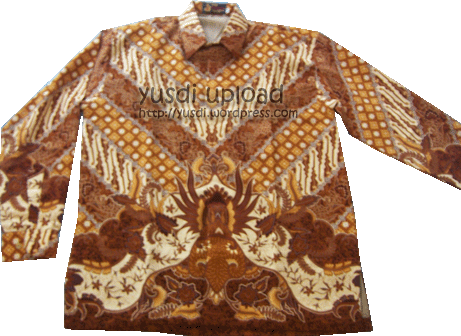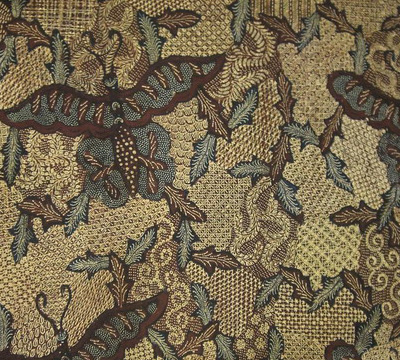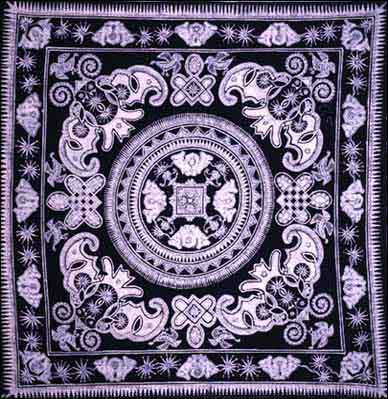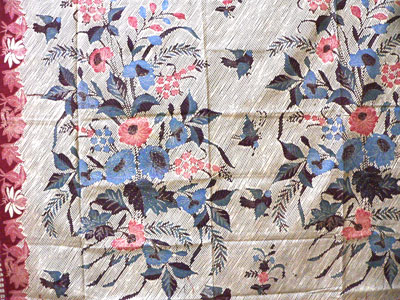

September 23, 2005
Pekalongan promotes batik through festival
Suherdjoko, The Jakarta Post, Pekalongan
As many as 1,000 women, all batik artisans, were sitting on small seats, forming a human line along Jl. Diponegoro, the street that surrounds the ex-residency office in Pekalongan municipality, last Friday.
In their right hands they held canting -- small dippers used to apply wax in batikmaking -- while their left hands held the same single piece of a 1,000-meter-long white cotton cloth. A small stove with a container containing boiling wax was placed beside each of the artisans.
Skillfully, they applied the hot wax to the cloth, painting different batik motifs on it. Yes, they were making a 1,000-meter batik and were attempting to break the record for the longest batik ever made in a single day. They started at six in the morning and had to finish at four in the afternoon.
Called Batik On The Road, the program was part of the four-day Pekalongan Batik Festival held last week from Sept. 15 through Sept. 18. The festival was held for the first time in 2003.
The compound of the ex-Pekalongan Residency Office next to Jetayu Square (or Simpang Lima as it is also popularly called) was the venue for the festival. Various programs, ranging from batik exhibitions, talks, seminars and fashion shows were conducted during the festival. An antique VW beetle and a scooter covered with batik motifs were also displayed at the compound. Also no less attractive was the giant batik kebaya shirt hung on a tree. Measuring 8.8 meters high and 5.4 meters wide, and with sleeves 5.8 meters long, the giant shirt was adorned with kipas batik motifs.
"We needed a month and spent Rp 10 million to make it," batik producer Rusdiyanto, who was also the initiator of the giant shirt, told The Jakarta Post.
Visiting the festival, one indeed could learn much about how batik has developed over time. Traditionally only used for a long cloth locally known as jarik, it is now used to make shirts, skirts, and even home decorations.
The motifs, too, that initially only depicted animals or plants, have now expanded to include almost anything. Through the fashion show that was held at the Kajen Hall in Pekalongan regency, people could see for themselves how elegant batik fashion could be. Introduced into the Javanese community in the 17th century, batik has indeed already gone international.
Through the dialog on Batik Fashion Trend 2006 presented by noted fashion designer Poppy Dharsono, people had the opportunity to ask many questions about batik fashions. Another renowned fashion designer, Iwan Tirta, was also invited to talk about batik at an international seminar held during the festival.
All the activities were held in a bid to promote Pekalongan as a batik center; as a place that was well worth visiting by batik lovers from around the globe.
"We want to make Pekalongan famous because of its batik. We want to make people remember Pekalongan whenever they talk about batik," said chairman of the festival's organizing committee Romi Oktabirawa, adding that batik so far had always been associated with Yogyakarta, Surakarta, Madura and Cirebon.
In fact, he said, Pekalongan batik had its own specific character, especially because it had no ties with the tradition of a palace like that of Yogyakarta or Surakarta. As such, the ornaments of Pekalongan batik were quite varied and free. The colors, too, were much brighter and stronger.
"They're not only dominated by brown, black, or gray, but also bright red, green, blue, orange, yellow, and others, making Pekalongan batik very specific compared to others," Romi, who is also a batik producer, explained.
What was concerning, however, was that although the marketing of Pekalongan batik had reached the international market, most of the batik producers in Pekalongan were recognized more as suppliers. They did not have direct access to the global market. "Through the festival, therefore, we want to attract buyers to come directly to Pekalongan. That will make it possible for batik producers here to make direct transactions with buyers," Romi said.
Khumaidun of Madoong Batik Natural Style agreed, saying that through direct transactions the price would be much better for them. So far, he said, it was mostly brokers who controlled the price of their batik products. "We hope that by encouraging buyers to come to Pekalongan and make direct transactions with us, we will make better profits compared to that of indirect transactions through brokers," said Khumaidun.
Pekalongan is actually well-known locally as one of Central Java's batik centers apart from Surakarta and Sragen. Of the 344 companies in Pekalongan, some 80 percent are batik companies.
Many efforts have been made to promote Pekalongan batik. Among them was the establishment of a wholesale center on Jl. Kali Banger in Setono in 2000, with 46 batik stores. Here people can buy batik products at a relatively cheap price.
However, most of the producers still find it difficult to penetrate the international market, mostly due to lack of knowledge.
"Most of us do not understand the concept of, for example, an LC (letter of credit). Most of us prefer to have cash-and-carry transactions," said Rusdiyanto, expressing hope that the festival would make Pekalongan more popular among potential buyers.
The organizing committee noted that some 185 observers from Malaysia, Canada, Germany and Japan visited the festival this year.
This has been seen as a "fresh breeze" for the batik industry in the region.
http://old.thejakartapost.com/detailfeatures.asp?fileid=20050923.P02&irec=1











/desi/2006/jiunkpe-ns-patterns_(design_elements)-2006-41405041-3930-sarung_batik-resource1-preview.jpg)







No comments:
Post a Comment